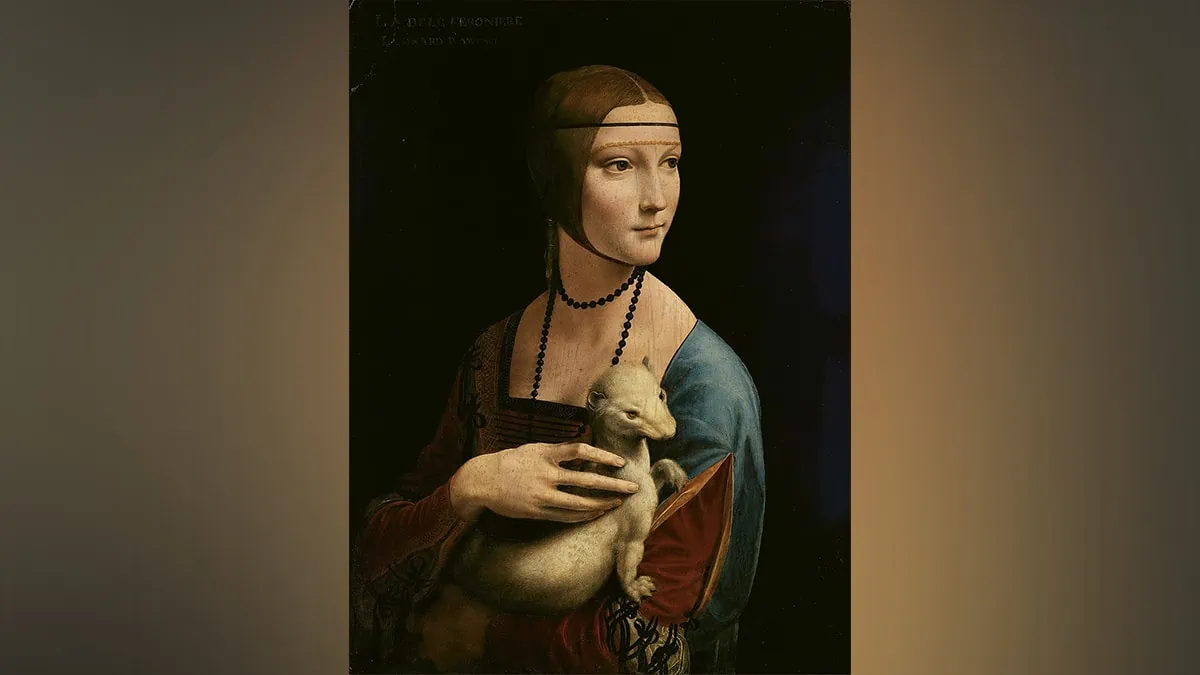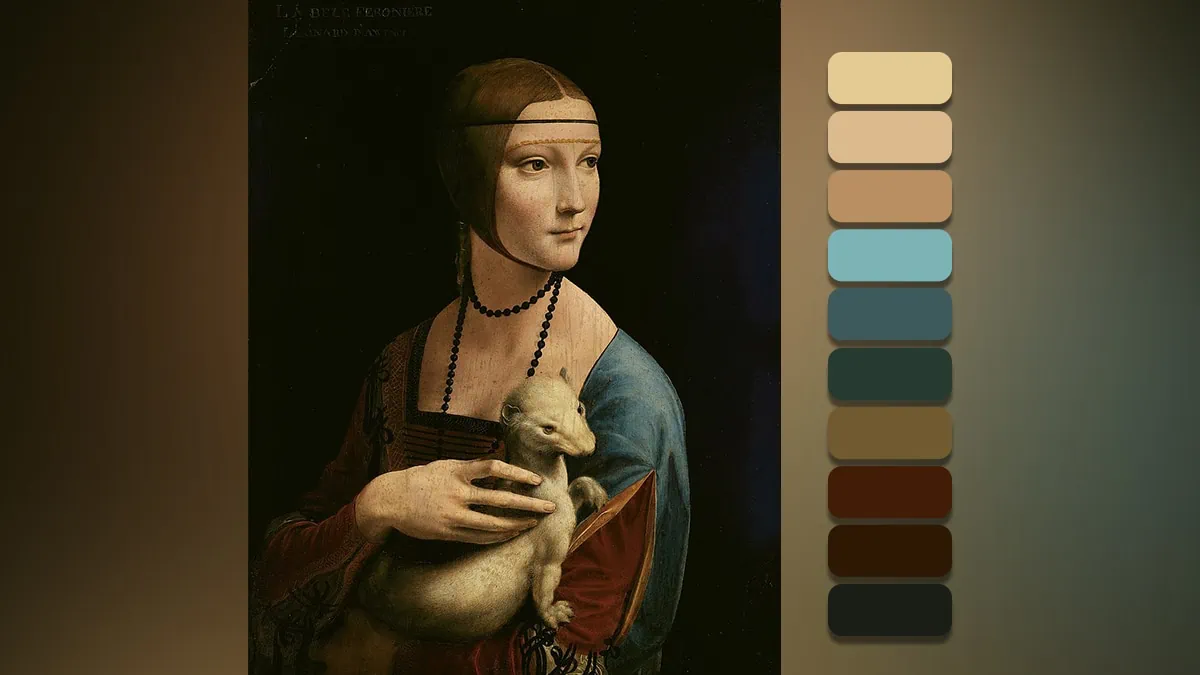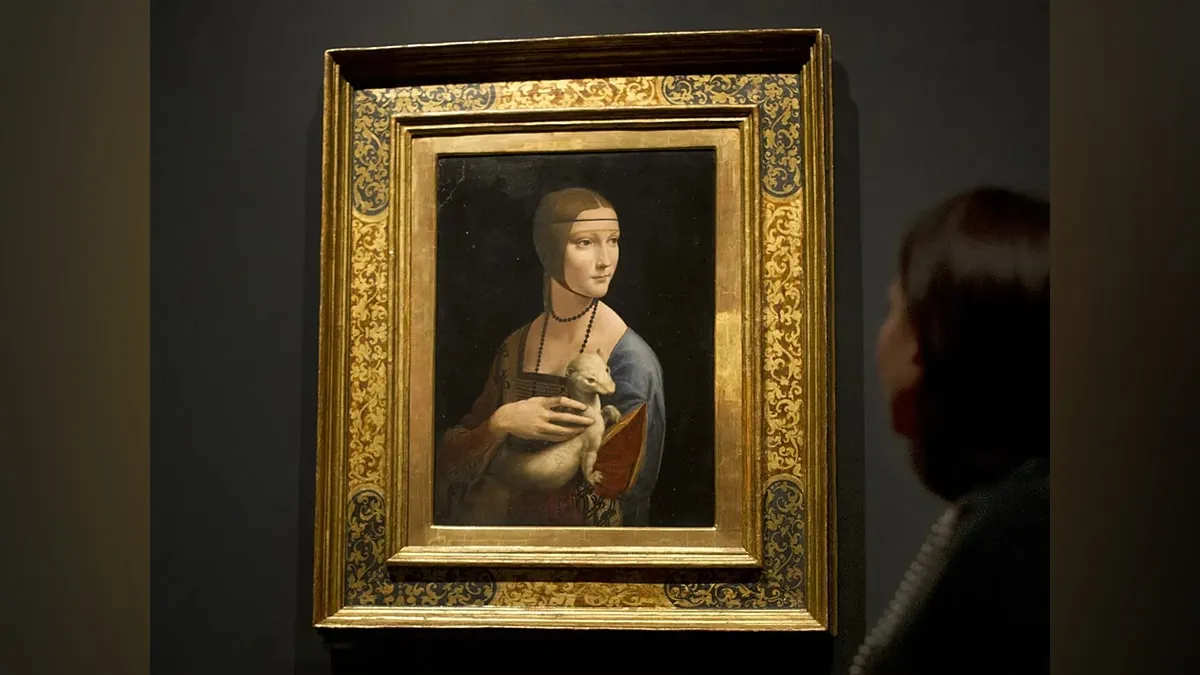An interesting fact: Before the famous Mona Lisa, there was an artwork that possessed similar traits.
The artwork features a lady holding almost the same facial expression as that of the Mona Lisa.
This is another oil creation by Leonardo that remained away from the limelight.
I’m talking about the painting that you know but the story you don’t—Da Vinci’s Lady with an Ermine!
Everyone called it the second Mona Lisa by Vinci, but it was actually created before the Mona Lisa artwork.
Have you ever wondered who the lady in the painting is? Why is she holding an ermine?
What could be the real reason that led Leonardo to paint such an art?
And why was it called the second Mona Lisa, despite the fact that it was created before?
Today in this blog, we’ll discuss everything about Lady With an Ermine and share some interesting facts that will fascinate you with its reality.
Writer’s tip: Don’t miss out on the conclusion!
Table of contents
Man Behind the Art

Before diving into its history, we must acknowledge the man’s effort who gave us a piece to talk about.
Mr. Leonardo da Vinci!
A painter, a sculptor, an architect, a draughtsman, an inventor, a scientist, and so on.
Phew! If I keep going, there will be a list added to this blog.
But do you know how he was chosen as the artist for painting Woman with Ermine?
Leonardo served Ludovico Sforza (also known as “Il Mora”) in Milan.
There he received a commissioned artwork by Sforza to paint “Last Supper” and, of course, “Lady with an Ermine.”
Ludovico Sforza was in love with the lady you can see in the picture.
Yes, it’s a painting made to showcase one’s love.
But the sad part is that they never married.
There were a lot of things that happened while and before creating Lady with an Ermine, which we’re going to discuss in detail.
Suggested read: Salvator Mundi by Leonardo da Vinci
Backstory of Da Vinci’s Lady With an Ermine

We always talk about the paintings that are famous.
However, we forget that there is always a piece in the past that led to its fame.
Have you ever thought about what would happen if the Mona Lisa had never been stolen? Would it ever be famous?
Certainly, painting Lady with an Ermine didn’t receive fame in the beginning.
Later, it came out as the second Mona Lisa, which had a huge impact on the painting.
The audience started to notice the work and ask questions about who the lady in the artwork was.
This question and the subject spread like wildfire.
Who was the lady with Ermine?
The lady in the painting is Cecilia Gallerani, who belonged to a non-aristocratic family.
Known for her intellectuality and poetry at the Milanese court, she was also a music lover.
It was under these scenarios that she met Ludovico Sforza and fell in love.
Even so, Sforza married a lady named Beatrice.
Despite his marriage, the relationship between him and Cecilia never drifted apart.
He also bought identical dresses for her and his wife.
There was a rumor about Gallerani being his mistress.
Reportedly, she was pregnant when Da Vinci drew a portrait of a lady with an ermine.
In my opinion, Sforza was obsessed with Cecilia because asking a famous Renaissance artist to draw a portrait of a lady was a big deal.
To know more about this renaissance famous painting of women, why not jump straight to the subject and examine Leonardo’s skillful masterpiece?
Suggested read: Harlem Renaissance
Subject Overview of Lady with an Ermine
Here comes Lady with an Ermine analysis, which you’ve been waiting for.
Exploring Leonardo’s artistic style is one of my favorite things to do. Let’s take a look!

a. The Lady
A perfect proportion in art does exist when it’s Leonardo’s creation.
You can’t blame me. I mean, just look at the sophisticated look that the face illuminates.
He was definitely good at painting women.
Cecilia is depicted in a three-quarter posture, which is neither in profile nor a full frontal view.
Do you know the method Leonardo used in the Lady with Ermine painting?
He used contrapposto, which he also incorporated in his earlier work, “Angel in the Virgin of the Rocks.”
This technique gave him the perspective to see Cecilia as exceptional.
Image: wikimedia

b. The Smile
How can we miss the most significant part of the painting?
As I mentioned, Da Vinci’s Lady with an Ermine was believed to be another Mona Lisa.
Why?
The enigmatic smile of Cecilia captivates all the attention of the viewer.
Tell me, what are your thoughts on this mysterious smile?
Neither negative nor positive, right?
It is difficult to predict what Cecilia was thinking with that smile on her face.
According to sources, she was pregnant during the creation of this self-portrait.
From where I witness she appears confused about how her relationship really stands with Sforza.
She is not married to him; he has commissioned a self-portrait for her, and she has his baby in her womb.
Clearly, we can get a perspective from Cecilia’s eyes!
Well, it’s totally my perception and an obvious thought about a woman.
Image: wikimedia

c. The Ermine
Ermine! Till now, I’ve been through numerous interpretations about the ermine in the painting.
Everyone has different opinions about the animal and the way he is featured in the art.
1st interpretation: The ermine symbolizes purity and morality.
It was believed that the animal was chosen to recall Cecilia’s personality.
To underline her as a person when a viewer has their first glance.
2nd interpretation: Some also believed that Vinci wanted to play with Cecilia’s surname.
When you translate ermine into old Greek, it means “gale,” and Cecilia’s surname was Gallerani.
I guess it all adds up now!
3rd interpretation: It was also noted that Ermine has a personal significance with Sforza.
He used it as his personal emblem.
Ermine representing Ludovico was one of the most common perspectives I’ve been through while doing my research.
I’ve added all the possible analyses for Ermine. Now it’s up to you which you believe the most.

d. The Attire
How about we examine it from the top?
You see a black, thin line, right? That thing is known as a hair band (also described as a silk band).
As you gradually move down, there is another golden braid-style band above her eyebrows.
Her hair also appears to be held under her chin and her hair braid is covered by cloth.
Below that, you can witness a black pearl neckpiece rounded through her neck.
Some sources call it “amber” or “black beads,” or even “stone.”
Cecilia’s dress belongs to the “Spanish” style.
Over her left shoulder (our right) is a blue sbernia, which covers her dress with a split in front.
The whole presentation is a 100 for sure!
To understand lady with an ermine meaning in a better way, how about we look into the function of art?
But before that, can you imagine how amazing this Da Vinci’s creation will look on your wall?
Click on the link below and get one “Lady with an Ermine” for your abode too, because mine is on it’s way!
Color Theme and Textures

A question for you all: What did you first see in the painting or where did your eyes fall first?
The face or her smile, right?
If yes, then Leonardo’s trick was a success. He exactly wanted this from his viewers.
If you take your first glance at Da Vinci’s Lady with an Ermine, you’ll enter a space where the light is focused on one side of the painting.
Leonardo beautifully captured the essence of Cecilia.
The light source is suggested from the right side of the painting, which brings all the focus to the left side of the art.
Cecilia and Ermine’s right side (our left) is more in shadow, which shows Leonardo’s brilliant use of chiaroscuro (contrast of light and dark).
The color represents the perfect balance of unity and harmony in art.
He was an innovator of the sfumato technique, which he used in the painting.
Unraveling Mysteries: To Conclude

Of course, some mysteries and secrets are must to have for a painting to become popular.
I told you in the beginning that the conclusion would leave you surprised.
Here it goes!
Da Vinci’s Lady with an Ermine is a restored painting.
Yes, you heard me right.
It suffered damage and had to face changes on the left side of the painting.
1961 was the year when Kenneth Clark (an art historian) asserted that Lady with an Ermine by Leonardo da Vinci had been repainted.
Later, David Bull, a technical analyst at the National Gallery of Art, discovered that the background of the painting was particularly damaged.
The background was originally bluish-grey and was painted black.
Even the signature of Leonardo was added to give it an authentic effect.
Wow!
Hello Vinci Lovers
What an interesting painting, right?
I’ve talked about numerous artworks but this particular painting caught my attention with its puzzling views.
Did it have the same effect on you?
Share your perspective or questions with me in the space below, which is open to all.
I will be waiting for your feedback, lovelies.
Keep reading and exploring. See ya!
FAQs
Leonardo da Vinci’s woman with ermine is a symbol of two lovers.
The Da Vinci Lady with an Ermine and the Mona Lisa portray women as their subjects. But the fact that makes the Mona Lisa the most famous is its enhanced and realistic portrayal of human beings.
Ermine meaning in the art speaks about purity and virtue. Ludovico, the lover of Cecilia, used ermine as his emblem.
The woman in the painting is Cecilia Gallerani (known for her intellectuality).
This classical painting of a woman was a commissioned work where Cecilia’s lover, Ludovico, wanted to give her a self-portrait with the emblem of Ermine that represents him.






